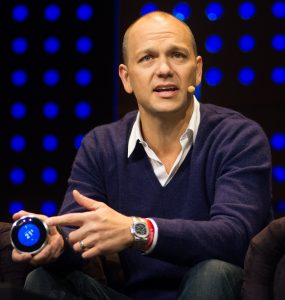Elizabeth Holmes and Tony Fadell were irritated by processes that others accepted as status quo. Learn how these superstars moved from Irritation to Innovation.

photo courtesy of www.theranos.com
Elizabeth Holmes hates needles. To her, the idea of being poked by a needle and withdrawing blood is more than just unpleasant. When she knows that she has to give blood, she becomes consumed and overcome with the thought until it’s finally over.
So it should be no surprise that at age 19 she founded Theranos, a ground-breaking blood diagnostics company that 11 years later is worth more than $9 billion. The company has patented its secret technology of performing 200 different blood tests (soon growing to over 1,000 different tests) without using a syringe. They use a few drops of blood drawn using a finger stick to minimize discomfort, and collected in a “nanotainer”; a container the size of an electric fuse. Her board is stocked with powerful blue chip members including former cabinet secretaries, former U.S. senators and former military brass. Theranos’ innovative technology is poised to transform health care technology at no more than half the cost of similar tests using current technology.
Holmes leveraged a process that irritated her to innovate a new method of getting it done.
Productive Dissatisfaction

photo courtesy of en.wikipedia.org
Tony Fadell was building a vacation home for his family. One of the seemingly mundane decisions was selecting thermostats, but he wasn’t satisfied with his choices. So he developed the Nest Learning Thermostat, a digital and WiFi enabled device that conserves energy by learning it’s owners habits. He also designed the Nest Protect which uses new technology to detect smoke and carbon monoxide.
Fadell’s real goal is to use technology to redesign and control all technology in the home. He was successful in raising startup capital as a result of his Apple pedigree, and extensive connections in Silicon Valley. He previously led the team that created the iPod, thereby rejuvenating Apple and transforming the music industry (yes, I love iTunes), and assisted in the development of the iPhone. Fadell left Apple in 2008 (along with his wife who was an HR executive there) and his thermostat irritation became the epiphany to innovate his next career move. As evidence of his success, Nest was purchased by Google earlier this year for $3.2 billion.
Innovation Mindset
Holmes and Fadell were irritated by processes and technology that others accepted as status quo. Obviously this wasn’t just a minor irritation either. Most of us would have dismissed it, avoided it, complained a bit while it was on our minds, then moved on to what we believed were more important things. We would think that change wasn’t needed, or that technology couldn’t effectively be applied to it and scaled for use. Instead, they saw it as a challenge and took the opportunity to do something about it. They had a mindset for innovation that they applied to their environment.
At the time, Holmes was a sophomore at Stanford, and according to her chemical engineering professor, viewed complex technical problems differently than other students. She dropped out shortly thereafter and persuaded her parents to invest her education fund into the business start-up.
Fadell’s tenure at Apple was distinguished by asking lots of questions, challenging Steve Jobs, and building his network in the “valley” outside the company; something normally reserved for Jobs himself. He didn’t conform to the typical concept of the Apple executive.
The Key to Innovation
So what is the key to your innovation? What is it that irritates you, but you find it difficult to simply walk away or ignore it? Instead, you keep trying to figure it out. This may be your opportunity to move from irritation to innovation; to find new approaches to address old ways of doing things. Though Holmes and Fadell applied innovation on a large scale, you can easily do this within a smaller sphere of influence; in your work team, organization, community group or family. Here are a few simple steps.
1. Tap into what’s irritating you. What problem needs to be solved? Chances are it’s right in front of you.
2. Find the benefit. Who will it add value to? Identifying your stakeholders will help you to target what action to take, and encourage you to stick with it for their benefit.
3. Ignore the naysayers. What do you believe is possible? If you don’t have faith in yourself, no one else will either.
4. Identify all the assumptions associated with the status quo. Why do people do it this way? Calling them out individually helps to break the innovation opportunity down into workable sizes for better analysis.
5. Methodically challenge each assumption. Why? Why? Why? Why? Why? By the time you’ve asked “why” five times, you’ll uncover some suppositions that really don’t have a strong foundation.
6. Think of a new approach. What if we did it this way instead? Then think of another different approach. This practice gets you into the mode of change.
If you’re really irritated, true innovation will typically involve transformation, not evolution. It will yield a totally unexpected outcome that represents a leap ahead, not just a step forward. So embrace that impatience and exasperation with the current situation, and press forward to a new mindset of innovation.
 Priscilla Archangel, Ph.D. is a seasoned leadership consultant, executive coach, author, speaker, and teacher. She has a passion for developing leaders, and motivating individuals and organizations to align their values, behaviors and goals with their purpose. Visit priscillaarchangel.com.
Priscilla Archangel, Ph.D. is a seasoned leadership consultant, executive coach, author, speaker, and teacher. She has a passion for developing leaders, and motivating individuals and organizations to align their values, behaviors and goals with their purpose. Visit priscillaarchangel.com.







Add Comment